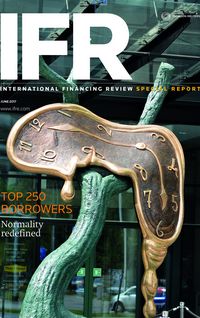US dollar-denominated bonds have never been more popular. The asset class has just enjoyed yet another stellar year, benefiting from global demand for dollar debt of all types and stripes. But how long can the party last?
In a turbulent and oftentimes chaotic world, there is something comforting about the market for US dollar-denominated debt. It is an asset class that, like denim, never seems to go out of fashion.
Nor is it likely to, at least for the foreseeable future. Each year, wise heads knock together and fret mildly about the asset class’s future. And every time those concerns prove unfounded. Rates do not rise - and issuance surges. Rates do rise - and sales swell again. Emerging-market gloom, domestic political uncertainty, an ongoing crackdown on tax inversions: none of it puts so much as a dent in the market.
Look at the data. According to Thomson Reuters, US$933.5bn of bonds were issued in US dollars by all corporates in the 12 months to the end of April 2017, a year-on-year rise of 19.4%. Technology led the way, with issuance up 26.1%, to US$143.8bn, followed by industrials, which saw volumes rise 22% year-on-year, to US$101.1bn. Issuance by real estate firms jumped 130%, from a lower base.
The number of prints rose in every category bar retail, while stress in some sectors, most notably oil and gas, was, said S&P Global Ratings credit analyst David Tesher, “handily replaced by rising issuance in solid or booming sectors such as auto, pharma, technology and chemicals”.
The factors that underpin the market and which lend it impetus are legion. But they can be boiled down to a trio of drivers.
First up is the asset class’s most attractive feature: itself. US dollar bonds are in the ultimate sweet spot, and have been for some time. Investors love buying them, as they are safe while dishing up a tempting enough portion of yield. And treasurers love issuing them because they are so wonderfully cheap to print.
Take the latter point first. Barring another crisis, US interest rates are only likely to continue to head upward. The Federal Reserve has raised rates by 25bp on four occasions over the past 18 months, pushing its Federal funds target to between 1% and 1.25%, in a increasingly concerted attempt to normalise an improving economy.
Yet this has not deterred issuers, who still see a wonderfully benign market.
“When compared to the past 20-25 years, from a rates perspective we are still at near-historic lows, so when treasurers look at where we are, they still see an incredibly attractive market for issuance,” said Richard Wolff, head of US bonds, project bonds and private placements at Societe Generale CIB. “Despite the recent move higher in rates, if an issuer can print a 10-year trade off a 2.35% or 2.40% benchmark, from a historical perspective, that still looks very attractive.”
Safe place
Investors in turn look at the dollar and see returns (more, certainly, than the quantum of yield served up by euro prints) but also security.
“The overwhelming majority of investors, whether sovereign wealth funds or insurers, want dollar-denominated investment-grade bonds,” said one New York-based banker. “There’s no better place to be right now than in the shoes of the treasurer of a big, safe, steady, boring US-based multinational.”
These perfectly balanced metrics are unlikely to change in the near term. The Federal Reserve could raise rates by a quarter of a point eight times this year, and they would still be scuttling along near all-time lows. Thus, issuers can print now or next year (and probably the year after that) and still be certain of pricing at the best levels in more than half a century.
Driver number two is the current state of a global economy still stuck in recovery phase. Low rates are, of course, a lingering remnant of the financial crisis. But so are a host of factors that continue to underpin strong bond sales. The merger craze of recent years stemmed from central bank attempts to stabilise a financial system bent out of shape in 2008.
New rules aimed at making banks safer also kept rates low and reined in growth, causing corporates “to pursue inorganic growth via M&A”, said Mark Howard, US senior macro strategist at BNP Paribas. “It is more compelling for companies to buy rather than build, which has led to a continued surge in bond sales.”
This has not been a blowout year for M&A: there has not as yet been anything to rival Anheuser-Busch InBev’s upsized and heavily oversubscribed US$46bn print, issued in early 2016 to fund the takeover of rival SAB Miller. But deals do sprinkle the market. In the first week of June, investors placed US$5.2bn of orders for a US$1bn M&A print launched by fashion house Coach to finance the purchase of its rival Kate Spade.
Moreover, low growth and super-low rates have nurtured a vibrant market for higher yielding debt. It continues to be a virtuous circle, with corporates new to the issuance market, and often lacking an investment-grade rating, seeing their bonds snapped up by investors desperate for a splash of extra yield.
That allows investors to size up new companies by watching how they perform in a tough growth environment. When they meet or even exceed expectations, “they can refinance over and again under very favourable terms”, said S&P’s Tesher. “This year is actually panning out a lot like 2016, with a combination of existing borrowers opportunistically pushing out maturities and refinancing under favourable terms, and newly rated borrowers - the majority in the Single B category - coming to market.”
Lack of alternatives
And so to the final factor underlying the vibrant dollar debt market: the lack of plausible alternatives. The greenback remains the world’s only true reserve currency, a safe haven in an extended period of uncertainty and volatility. Dollar bonds plug corporates directly into a vast pool of capital desperate to be put to work. Issuers of every stripe barely need a second invitation to print: look at the emerging world, where sovereigns and corporates are printing dollar bonds at a record pace, selling US$179bn in the first quarter of 2017 alone.
And, really, what are the other options? Certainly not Europe, with its rock-bottom rates and spreads, or China’s still-illiquid offshore renminbi. Little wonder, notes S&P’s Tesher, that “investors with large pools of uninvested capital in a low-yield environment are so keen to buy corporate US dollar debt, across the ratings spectrum”.
Looking ahead, there are factors that may either hinder or further help the market for dollar debt. Help - the sort at least that will continue to perpetuate the asset class - is likely to come from an ageing population, particularly in North America and Europe, that covets bonds over stocks. Post-World War Two baby boomers, said SG’s Wolff, “typically are not going to take chances on the equity market. They will be looking for stable income sources, and with people living longer, it’s hard to imagine them switching from bonds, which can provide regular 4%-plus annual returns, into equities”.
Added momentum could also come from a new wave of mergers and acquisitions: not from American corporates buying one another, but from cash-rich European blue-chips seeking to ramp up their presence in the United States - an important consideration given President Donald Trump’s determination to bring jobs back home.
“If you have more European corporations targeting US companies for acquisitions, you would expect to see a significant portion of the acquisition-related financing in dollars,” said Wolff.
Remote chance
There is a remote chance that dollar bond issuance could slip. The market has been rocket-propelled for the past three years, but nothing lasts forever.
US interest rates might rise too far too fast, crimping sales. Likewise, bankers said, a sudden slowdown US GDP - unlikely but not implausible given the weak economic figures posted in the first three months of the year - could also lead to a slowdown in the market for junk bonds.
BNP Paribas’ Howard said a key theme that could emerge over the next 12 months is “a major downward migration from the Triple B sector of the US credit market. If we start to see more retail, telecoms, media and technology firms going from Triple B to Double B, or even Single B, it would be a double whammy. You’d see pain for holders of high-yield debt and it could cause a temporary slowdown in investment-grade issuance”.
A final uncertainty may come from Trump’s plan, briefly outlined in April, to repatriate cash by imposing a one-time tax on trillions of dollars held overseas by US corporates. If the plan is approved, said Howard, “it may lead to lower debt issuance as higher grade US corporates will have a bigger onshore pool of cash in which to dip - they simply won’t have to go to market as often”. Debt sales would slide in sectors like pharmaceuticals and technology, dominated by giant firms with huge reserves of cash stored offshore.
The chance of this happening in the near term, though, is remote. Trump has struggled to enact legislation despite boasting majorities in the Senate and the House of Representatives, and few believe his tax plan, at least in its current guise, will make it through Congress.
“Given the US government’s difficulties enacting change, it’s hard to imagine any major alterations in the tax code that would impact 2017 [bond] issuance,” said SG’s Wolff. “It might impact issuance in late 2018 and 2019, in the event that some of these rule changes come to fruition.”
The most likely outcome is, therefore, more of the same. More debt sales by more corporates and institutions of all levels of size and quality, in developed and emerging markets alike, issuing in the world’s sole reserve currency.
In a turbulent world that is fast becoming stretched at the seams, there is something comforting about this consistency.
To see the digital version of this special report, please click here
To purchase printed copies or a PDF of this report, please email gloria.balbastro@tr.com



